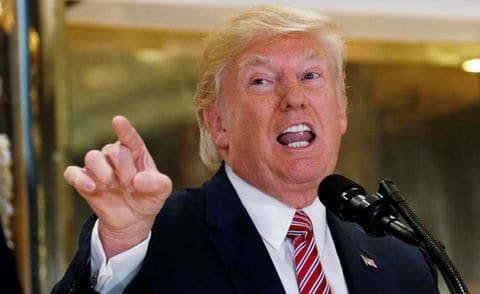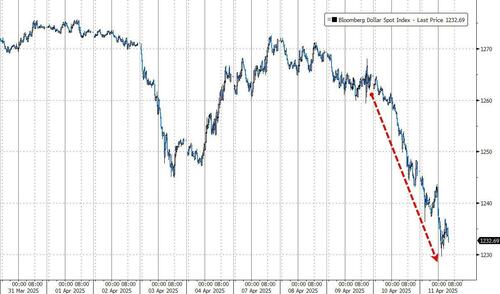Uddrag fra Deutsche Bank:
Deutsche Bank’s global head of FX, George Saravelos, argued yesterday that despite President Trump’s reversal on tariffs the damage to the USD has been done: the market is re-assessing the structural attractiveness of the dollar as the world’s global reserve currency and is undergoing a process of rapid de-dollarization.
Nowhere is this more evident than the continued and combined collapse in the currency and US bond market as this week comes to a close.
What is the endgame to this historic shift in the global dollar paradigm?
- US fiscal space is rapidly diminishing. We have long argued that a country’s fiscal space is determined by its external balance rather than its debt-to-GDP ratio: what matters for debt sustainability is a country’s reliance on foreign financing, reflected in the tight correlation between global bond yields and current account deficits. The US has been the exception to this rule, able to secure funding for its extreme twin deficits thanks to the dollar’s exceptional status. With this now changing, the steady state level of sustainable US fiscal deficits is moving lower. This reduces the flexibility of the US administration in pursuing expansionary fiscal policy to support growth, much in the same way the UK and France have faced similar constraints. US policy flexibility is becoming a lot more constrained going forward; this by extension implies greater headwinds to the growth outlook.
- Foreign policy will now influence US financial markets. The challenge for the USD and the US bond market is not just de-dollarization. It is that the twin deficit position requires ongoing funding from foreigners to be sustained. By extension, foreign investor risk sentiment becomes all the more important in ensuring bond and currency market stability. It is an oft-repeated phrase that a twin deficit country is dependent on the “kindness of strangers”. This now applies to the US, but by extension it will make the stability of US markets all the more dependent on non-confrontational foreign and economic policy to ensure their funding. We argued more than a month ago that references to the ownership of Greenland, for example, where contributing to an undermining of USD stability. We suspect the US administration will have to adopt a more conciliatory stance in international relations to maintain stability in the bond market going forward.
- Ultimately, it is all about valuations. A number of press reports have suggested that recent price action in the US resembles EM-like characteristics. This is true to the extent that the bond and currency markets are declining at the same time. But there is one key difference that will ultimately work to the US advantage: the economy does not have any large foreign currency liabilities that would lead to explosive debt dynamics. In contrast, currency and bond market weakness should ultimately lead to cheaper valuations and a new equilibrium of asset pricing that becomes attractive for foreigners to invest. The dollar’s biggest challenge at the moment is it’s starting point of high valuations, high foreign asset allocations and a confrontational foreign policy approach. This on balance significantly raises the valuation adjustments that need to take place to make US assets attractive again
As far as the rest of the world goes, all the shifts alluded to above are a double-edged sword.
Reserve currency alternatives such as the EUR may find that their fiscal space is going up, but they may also be burdened with greater currency appreciation that requires the respective central banks (ie the ECB) to turn more dovish.
Our concluding observation is that given the centrality of the dollar to the global financial system there are likely to be many unpredictable consequences to the epochal shifts in capital flow allocation that have been unleashed.
We think the process of de-dollarization has more to go, but we are keeping a very open mind as to how this process plays out and what the ultimate new equilibrium in the global financial architecture will be.



